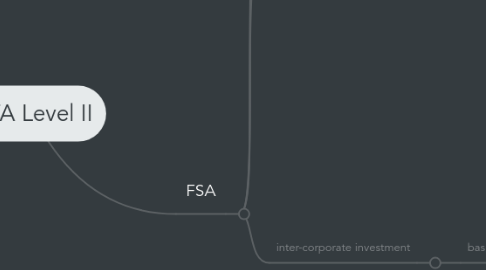
1. FSA
1.1. inventory
1.1.1. inventory cost
1.1.1.1. in cost(for production)
1.1.1.1.1. physical goods cost
1.1.1.1.2. freight in
1.1.1.1.3. storage cost?
1.1.1.1.4. conversion cost(转换成本)
1.1.1.1.5. fixed production overhead
1.1.1.2. out of cost
1.1.1.2.1. allocated overheads
1.1.1.2.2. abnormal waste
1.1.2. inventory value
1.1.2.1. physical flow of inventory
1.1.2.2. cost flow(cost fomula IFRS)
1.1.2.2.1. FIFO
1.1.2.2.2. LIFO
1.1.2.2.3. WAC
1.1.2.3. formula
1.1.2.3.1. EI=BI+purchase-COGS
1.1.2.4. pricelevel
1.1.2.4.1. inflationary
1.1.2.4.2. deflationary
1.1.3. record change
1.1.3.1. perpetual
1.1.3.1.1. 随时updated
1.1.3.2. periodic
1.1.3.2.1. 最后时间点评估
1.1.4. LIFO reserve
1.1.4.1. inflationary & qunatity stable or increase
1.1.4.1.1. >0
1.1.4.1.2. increase
1.1.4.2. B/S
1.1.4.2.1. 存量=InvF-InvL
1.1.4.2.2. DTL (fifo)=accumulated LIFO reserve*t
1.1.4.2.3. CashF-CashL=LIFO reserve*t
1.1.4.2.4. R/Ef-R/El=LIFO reserve * (1-t)
1.1.4.3. IS
1.1.4.3.1. COGSf-COGSl=dLIFO reserve
1.1.4.3.2. GPf-GPl=dLIFO reserve
1.1.4.3.3. Taxf-Taxl=dLIFO reserve*t
1.1.4.3.4. NIf-NIl=dLIFO reserve*(1-t)
1.1.4.4. decline
1.1.4.4.1. price failling
1.1.4.4.2. inventory quantity declining
1.1.5. adjustment
1.1.5.1. US GAAP(lower cost or market)
1.1.5.1.1. ceiling=NRV
1.1.5.1.2. flooring = NRV-normal profit margin
1.1.5.1.3. replacement cost
1.1.5.2. IFRS(cost NRV)
1.1.5.2.1. NRV=sales price - selling cost
1.1.5.3. inventory allowence (negative effect保守)
1.1.5.3.1. B/S
1.1.5.3.2. IS
1.1.5.3.3. permanent
1.1.6. analysis
1.1.6.1. raw/in progress +,inventory +
1.1.6.1.1. demand+ sales+
1.1.6.2. finish goods + in progress - inventory -
1.1.6.2.1. read strategy
1.1.6.3. growth rate at finish goods vs sales
1.1.6.4. MD&A
1.1.6.5. with inventory allowence and not
1.2. Long live asset
1.2.1. cap an expense
1.2.1.1. NI *,equity +,CFO +
1.2.1.2. asset +
1.2.1.3. IS
1.2.1.3.1. profitablity in early year
1.2.1.3.2. profitablity in later year
1.2.1.3.3. income variablity
1.2.1.4. B/S
1.2.1.4.1. capitalized
1.2.1.5. Cash Flow
1.2.1.5.1. capitalized
1.2.1.6. on-going purchase
1.2.1.6.1. profit enhancing effect
1.2.2. Capitalized Interest
1.2.2.1. constructed asset(fixed asset)
1.2.2.1.1. planet or building
1.2.2.2. inventory(current asset)
1.2.2.2.1. build for sales
1.2.2.3. coverage ratio
1.2.2.3.1. EBIT/I +, t=0
1.2.2.3.2. High aset to lower NI t=T
1.2.3. Capitalized tangible asset
1.2.4. Capitalized intangible asset
1.2.5. impairment
1.2.5.1. cost model
1.2.5.2. expected future cash flow < carry value
1.2.5.2.1. No: no impairment
1.2.5.2.2. yes: impairment loss
1.2.5.3. impact
1.2.5.3.1. this year
1.2.5.3.2. subsquent year
1.2.6. revaluation(IFRS)
1.2.6.1. fair value
1.2.6.1.1. downward
1.2.6.1.2. upward
1.2.7. disclosure
1.2.7.1. useful life
1.2.7.2. SV
1.2.7.3. depreciation method
1.2.7.4. calculator
1.2.7.4.1. average age
1.2.7.4.2. ave dep life
1.2.7.4.3. remain useful life
1.3. Lease
1.3.1. Capital leasee
1.3.1.1. criteria
1.3.1.1.1. transfer title
1.3.1.1.2. bargin purchase option
1.3.1.1.3. 75% economic life
1.3.1.1.4. 90% FV
1.3.1.2. indicator
1.3.1.2.1. A+ Liable+
1.3.1.2.2. NI - this year,NI + later year
1.3.1.2.3. EBIT+
1.3.1.2.4. CF
1.3.1.2.5. coverage ratio
1.3.1.2.6. current ratio
1.3.2. leaser
1.3.2.1. sales type
1.3.2.1.1. PV<CV of COGS
1.3.2.2. direct financing lease
1.4. inter-corporate investment
1.4.1. basic categories
1.4.1.1. influence not significate(0-20%)
1.4.1.1.1. financial asset (passive investment)
1.4.1.2. significate influence(20%-50%)
1.4.1.2.1. associate
1.4.1.3. share
1.4.1.3.1. join venture
1.4.1.4. Control
1.4.1.4.1. subsidiary
1.4.1.4.2. minority interest(non-controlling interest)
